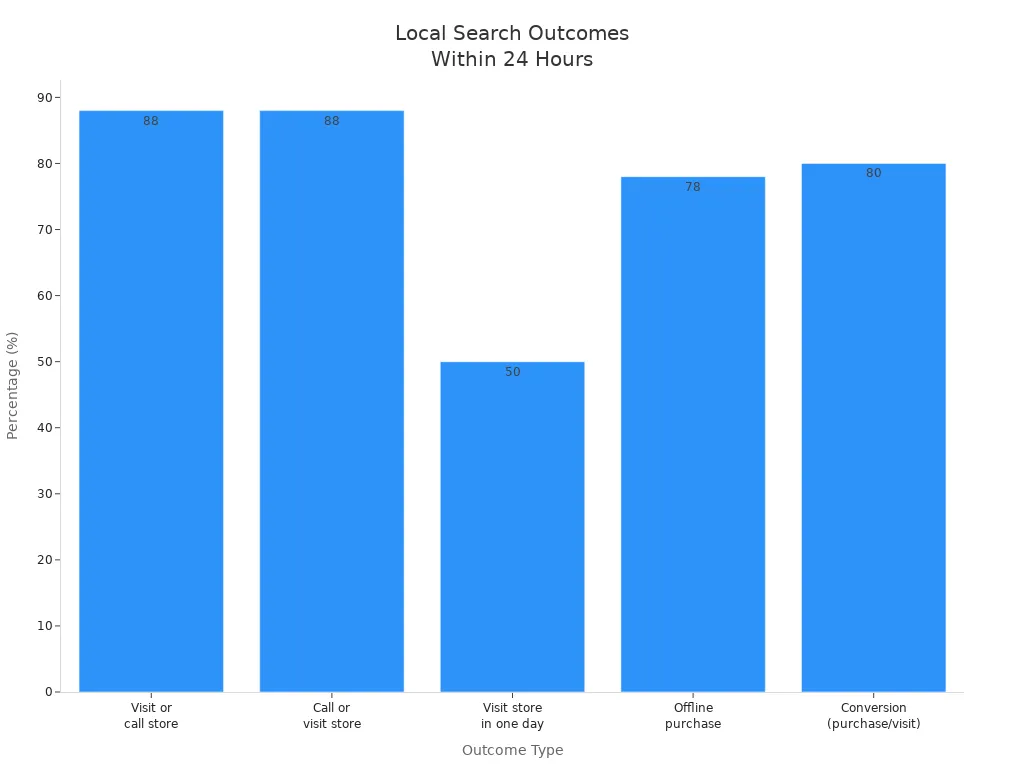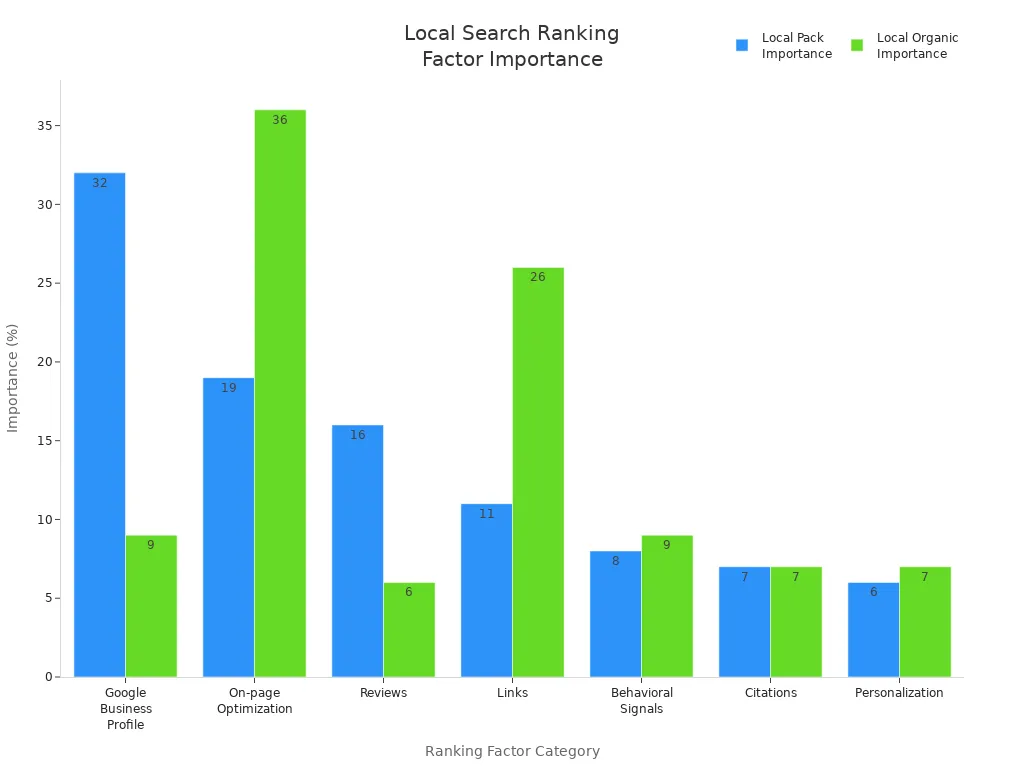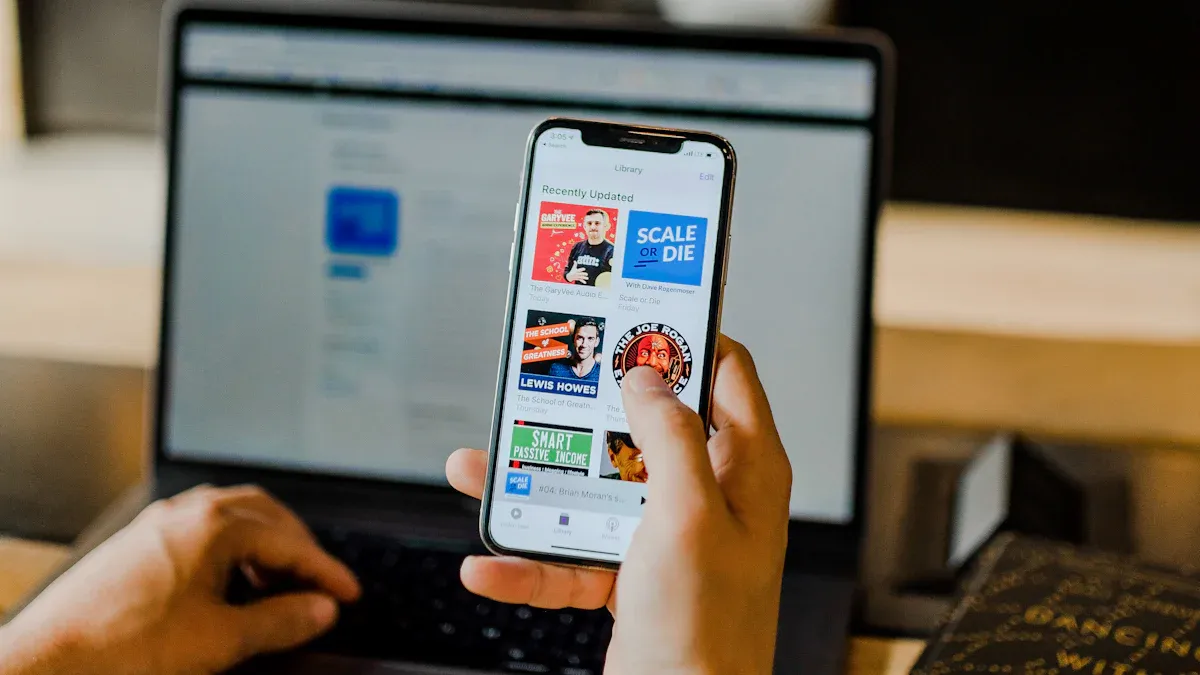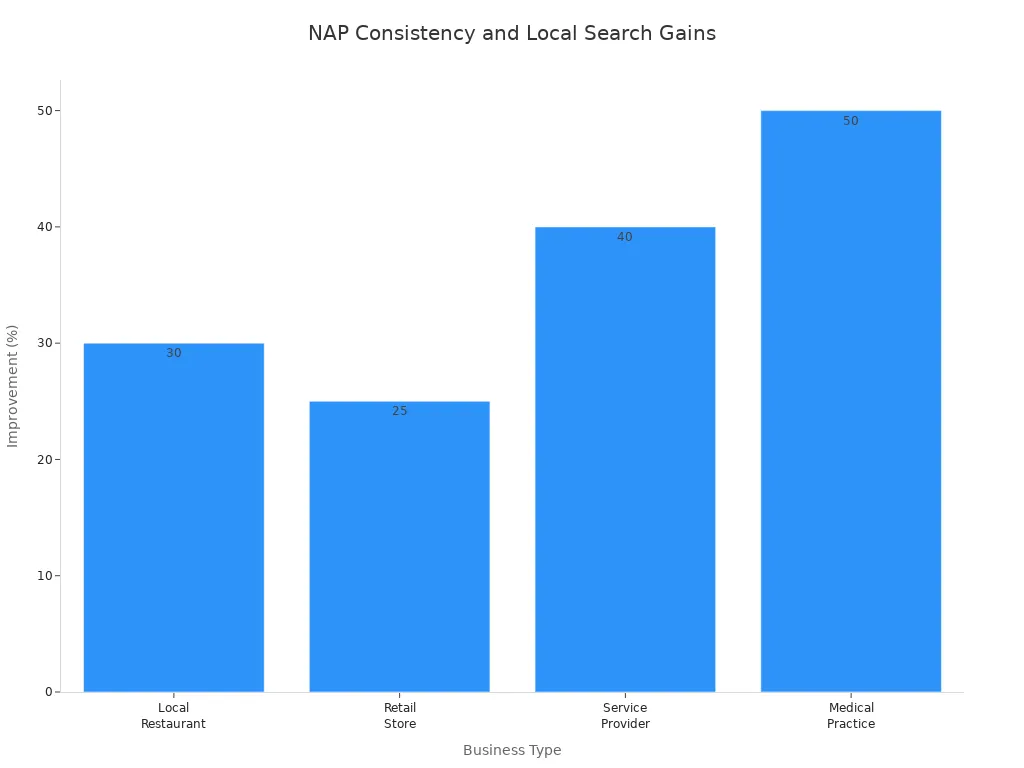Beat Your Local SEO Competition with Proven Steps

You want to outrank your competition in local search and attract more customers. Every day, 88% of people who perform a local search on their smartphones visit or call a business within 24 hours. 
Mastering local SEO competition gives your business an edge in local search results and helps you build a strong local customer base. When you focus on local SEO, you can outrank your competition, increase your visibility, and drive growth. Outrank your competition by taking proven steps that work for any business. With the right approach, you can outrank your competition, dominate local search, and see real results. Outrank your competition, grow faster, and watch your business thrive with local SEO competition. Outrank your competition and become the top choice in your area.
Identify Local Search Competitors
Find Local Competitors
To beat your local search competitors, you first need to know who they are. Start by searching your main business keywords in Google using Incognito mode. This helps you see which local competitors appear in the top spots for local search. Look at the Google Maps results, the local 3-pack, and the organic listings. Make a list of businesses that show up often. Use tools like LocalFalcon to scan your area and see which local search competitors rank above you for important keywords. Try location spoofing tools, such as BrightLocal’s Local Search Results Checker, to check results from different neighborhoods. Record the names, ranking positions, and how often each business appears. This process gives you a clear view of your main local search competitors.
Tip: Create a spreadsheet to track your findings. Note which local competitors appear for multiple keywords and in different parts of the search results. Focus on those with the most overlap, as they are your strongest local search competitors.
Analyze Their Online Presence
Once you have your list, it’s time for competitor analysis. Review each local search competitor’s Google My Business listing. Check how complete their profiles are, what categories they use, and how many reviews they have. Look at the quality of their photos and how often they post updates. Examine their websites for local keywords, location pages, and user experience. Use tools like SEOptimer to compare their online presence with yours. Study their social media profiles to see how they engage with customers. Pay attention to their review responses and the types of posts they share. This competitor analysis helps you spot strengths and weaknesses in their online presence. You can then use these insights to improve your own local search strategy and stand out among local search competitors.
- Top-performing local search competitors often have:
- Complete and optimized Google Business Profiles
- Consistent business information across all listings
- High-quality photos and frequent updates
- Strong review signals and quick responses
- Helpful, locally focused website content
By following these steps, you gain a deep understanding of your local search competitors and their online presence. This knowledge is the foundation for building a winning local search strategy.
Analyze Local SEO Competition
Understanding your local search competitors is key to winning local SEO competition. You need to look closely at their Google My Business, website, and local search rankings. This process helps you spot what works for them and where you can do better.
Audit Google My Business Listing
Start with a detailed competitor analysis of each google my business listing. Look for these important factors:
- Check which business categories your local search competitors use.
- Count their reviews and see how often they respond.
- Review their business name, address, and website link for accuracy.
- Study their photos, posts, and listed products or services.
- Use tools like PlePer or BrightLocal to compare categories and reviews.
- Make sure their NAP (name, address, phone) is consistent everywhere.
- Watch for duplicate listings that could hurt their rankings.
- Notice how they manage reviews, including speed and keyword use.
Tip: A well-optimized google my business profile is a top factor for local search rankings. Review signals, like the number and quality of reviews, also play a big role in local search results.
Review Website SEO
Next, analyze your local search competitors’ websites. Use this table to guide your competitor analysis:
| SEO Factor Category | Key Influencing Factors |
|---|---|
| On-Page Factors | Domain authority, NAP visibility, keyword use, content quality |
| Citation Factors | Accuracy and relevance of citations |
| Link Factors | Quality and relevance of backlinks, especially local ones |
| Google Business Profile | Business title, category, website URL authority |
| Review Factors | Google reviews, third-party reviews, recency, diversity |
| Technical & Security | Mobile-friendliness, HTTPS, site speed, proper indexing |
Check if their site is mobile-friendly, loads fast, and uses local keywords. Make sure their NAP matches their google my business listing.
Check Local Rankings
Track where your local search competitors rank in local search results. Use tools like Local Falcon, GeoRanker, or Whitespark for visual competitor analysis. These tools show you a map or grid of local search rankings, so you can see where your business stands compared to others.
| Tool | Key Visualization Features | Benefits for Competitor Analysis | Ideal Use Cases |
|---|---|---|---|
| Local Falcon | Grid-based ranking maps, real-time reporting | Pinpoints strong/weak areas, actionable insights | Hyperlocal competitor analysis |
| GeoRanker | Heat maps, geo-specific rank tracking | Monitors keyword performance, competitive insights | Multi-location businesses |
| Whitespark | Local pack tracking, citation management | Detailed rank tracking, competitor comparison | Small to mid-sized businesses, multi-location |

Google updates its local search algorithm often. You must keep up with these changes to stay ahead in local SEO competition. Focus on optimizing your google my business, website, and reviews to improve your local search rankings.
Optimize Your Google My Business Listing

Optimising google my business is one of the most important steps for local listing optimization. A complete and active profile helps you stand out in local search results and brings more customers to your business.
Claim and Verify
You need to claim your google my business listing before you can control it. Visit the Google Business Profile website and search for your business. If you find it, claim it. If not, create a new listing. Google will ask you to verify your business, usually by mail, phone, or email. This step proves you own the business and lets you manage your profile. Without verification, you cannot update your details or respond to reviews.
Tip: Claiming and verifying your listing is the first step in optimising google my business. Verified businesses appear more often in local search and Google Maps.
Complete All Details
Fill out every section of your google my business profile. Add your business name, address, phone number, website, hours, and business category. Make sure all information matches what you use on your website and other platforms. Inaccurate or missing details—like wrong addresses or outdated phone numbers—can lower your ranking and make customers lose trust. Studies show that businesses with complete profiles are 2.7 times more likely to be seen as reputable. They also see a 70% higher chance of customer visits and a 50% higher chance of purchase consideration.
- Double-check these details:
- Name, address, and phone (NAP)
- Business hours and holiday hours
- Categories and services
- Website link
- Description and attributes
Keeping your information accurate and consistent is key to optimising google my business and boosting your local search visibility.
Add Photos and Updates
Photos and updates make your profile more attractive and help you connect with customers. Businesses with photos get 42% more requests for directions and 35% more website clicks. Regularly upload high-quality images of your storefront, products, and team. Post updates about new products, special offers, or events. Google rewards active profiles with better rankings and more customer actions.
- 📸 Encourage customers to share their own photos.
- 📝 Post weekly updates to keep your profile fresh.
- 🎉 Share seasonal promotions or community events.
A well-maintained profile with fresh content helps you outperform competitors who neglect their listings. Optimising google my business with photos and updates signals to Google that your business is active and trustworthy.
Local SEO Content Strategy
A strong local content strategy helps you stand out in local search. You need to use the right local keywords and create content that speaks to your community. This approach boosts your local search optimisation and brings more customers to your business.
Local Keyword Research
You must start with local keyword research. This step helps you find the best local keywords for your business. Use these strategies to get ahead in local search:
- Add location-based keywords like your city, neighborhood, or phrases such as "near me" to your website and listings.
- Use SEO tools like SEMrush, Ahrefs, and Google Keyword Planner to discover local keywords your competitors target.
- Study your competitors’ websites to spot keyword gaps and new opportunities.
- Listen to your customers. Check reviews and surveys to see which local search terms they use.
- Focus on long-tail keywords with location details. These attract people ready to buy.
- Place local keywords in your title tags, meta descriptions, headers, and main content.
- Keep your Google Business Profile updated with consistent local keywords.
- Use tools like Moz Local and Google Trends to track search volume and trends.
- Update your keyword list often to match changing search habits.
- Make sure your business name, address, and phone number stay the same across all directories.
These strategies help you improve your local SEO, attract more local search traffic, and outperform your competition. Local keyword research is the foundation of seo localisation for businesses.
Hyperlocal Content
Hyperlocal content takes your local focus to the next level. You create content for people in your exact area. This approach increases your visibility in local search and builds trust with your audience.
- Write blog posts about local events, news, or community stories.
- Share updates about your business’s role in the neighborhood.
- Use social media to target people nearby with geofenced posts.
- Partner with local influencers or community groups to boost your reach.
- Highlight customer stories and reviews from your area.
Hyperlocal content makes your business feel like part of the community. You get more likes, comments, and shares. People trust you more and visit your business. Hyperlocal strategies also improve your local SEO and help you connect with local customers. When you use seo localisation for businesses, you build strong relationships and grow your brand.
A smart local content strategy uses both local keywords and hyperlocal content. This mix helps you win in local search and keeps your business top of mind.
Build Citations and Backlinks

Building citations and backlinks is a powerful way to boost your local SEO. You help search engines trust your business when you keep your information accurate and earn links from trusted local sources.
Consistent NAP
Your Name, Address, and Phone number (NAP) must stay the same everywhere online. Search engines use this information to decide if your business is real and trustworthy. If your NAP is different on Google, your website, or local business directories, you may lose rankings. Even small mistakes, like a missing period or an old phone number, can confuse search engines and customers.
- Consistent NAP across Google Business Profile, your website, and third-party listings builds trust with Google.
- Inconsistent NAP on sites like Yelp, Facebook, or Apple Maps can lower your local search rankings.
- Accurate NAP in every local citation helps prove your business is active and real in your area.
- High-authority directories, such as Yelp or BBB, give more SEO value when your NAP is correct.
- Common mistakes include typos, outdated numbers, and copy-paste errors.
Tip: Audit your listings often and fix any NAP errors right away. This simple step can give you a big boost in local search.
| Business Type | Action Taken | Result on Local Search Rankings and Traffic |
|---|---|---|
| Local Restaurant | Corrected NAP discrepancies | 30% increase in search visibility |
| Retail Store | Ensured consistent NAP on website and social media | 25% rise in foot traffic |
| Service Provider | Updated NAP on local listings | 40% boost in inquiries |
| Medical Practice | Fixed NAP inconsistencies | 50% improvement in local search rankings |

Local Backlinks
You can raise your local SEO authority by earning strong local backlinks. These links show search engines that your business matters in your community. Focus on local link building by getting links from local news sites, community groups, and local business directories. A single link from a trusted local website can move your business higher in search results.
- Get listed in local citation sources and business directories with accurate NAP.
- Reach out to local bloggers, news outlets, and community organizations for mentions or features.
- Partner with nearby businesses or sponsor local events to earn high-quality local backlinks.
- Create unique local content, like blog posts or infographics, to attract links from local journalists.
- Always choose quality over quantity. A few strong local backlinks from trusted sources help more than many weak links.
Local link building and accurate citations work together to improve your visibility and reputation. When you focus on high-quality local backlinks, you help your business stand out in local search.
Manage Reviews
Online reviews shape how customers see your business. They also play a big role in local SEO. When you manage reviews well, you build trust and improve your search rankings.
Get More Reviews
You need a steady flow of new reviews to stay ahead in local search. Customers trust businesses with many recent reviews. Here are some ways to encourage more feedback:
- Send a friendly email to customers after their visit. Explain how their review helps your business.
- Make the review process easy. Share direct links or QR codes to your Google, Yelp, or Facebook profiles.
- Respond to existing reviews. When customers see you reply, they feel valued and want to share their own experiences.
- Share positive reviews on your social media pages. This shows you care and motivates others to leave feedback.
- Train your team to ask for reviews after a good customer experience.
- Host community events to connect with customers and encourage them to share their thoughts.
Tip: Over 60% of customers look at the number of reviews before choosing a business. Make it simple for them to leave feedback, and you will see more reviews come in.
Respond to Feedback
Replying to reviews shows you care about your customers. It also helps your business stand out in local search results. Here is what happens when you respond to feedback:
- You show customers that you listen and want to improve.
- Your business looks more trustworthy and credible.
- Google sees your business as active, which can boost your local search rankings.
- Quick and professional replies lead to more reviews and better engagement.
- Reviews often mention your products and location, which helps your SEO.
A local dental practice started replying to every review within a day. Their ranking on Google improved from #9 to #3 in six months. They saw a 35% increase in review volume and an 18% growth in revenue. This proves that responding to feedback can help your business grow.
| Benefit of Responding | Impact on Business |
|---|---|
| Builds trust | More customers choose your business |
| Boosts SEO | Higher local search rankings |
| Increases engagement | More reviews and website visits |
When you reply to both positive and negative reviews, you show that you value every customer. This builds loyalty and encourages others to leave their own positive reviews.
Local Advertising and Community
Local PPC
You can use local PPC to get your business in front of customers fast. Local PPC ads show up at the top of search results when people look for services in your area. These ads bring quick traffic and help you target the right audience. Many businesses use PPC as part of their strategies to boost visibility during busy seasons or special promotions.
PPC gives you instant results, but you must pay for every click. If you stop your ads, your traffic drops right away. Local SEO, on the other hand, takes more time but builds steady, free traffic over the long term. When you compare both strategies, you see that PPC works well for short-term goals, while SEO gives you better results for sustainable growth. Small businesses often find that SEO strategies offer higher ROI because they do not require ongoing payments for each visitor.
| Aspect | PPC (Pay-Per-Click) | Local SEO (Organic Search) |
|---|---|---|
| Cost | Requires payment for each click, often high | No cost per click; traffic is free after setup |
| Timeline | Immediate results upon campaign launch | Takes weeks to months to build rankings |
| Sustainability | Short-term; traffic stops when ads stop | Long-term; traffic continues after setup |
| Trust | Ads can be ignored by users | Organic results are more trusted by users |
| Brand Building | Limited content engagement | Builds lasting content and brand authority |
| Competition | Competitors can outbid for ad positions | Harder for competitors to displace rankings |
You should use both strategies together for the best results. Start with PPC for quick wins, then focus on SEO strategies for lasting growth.
Community Engagement
Community engagement helps your business stand out in local search and builds strong relationships. When you sponsor local events or join community projects, you show that you care about your area. These strategies make your brand more visible and trusted.
- Sponsoring local events puts your name in front of more people and increases brand recall.
- Community involvement leads to positive word-of-mouth and more social media sharing.
- Active engagement shows you support local causes, which builds trust and loyalty.
- These strategies also boost employee morale and create a positive work culture.
- When you align your sponsorships with your brand values, you connect with your target audience in a real way.
- You can measure success by tracking social media reach, event attendance, and customer feedback.
Community engagement also helps your local SEO. When you sponsor events, you often get backlinks from event websites, news outlets, and community blogs. These links improve your search rankings for local keywords. Your business gains more exposure online and offline through media coverage and social media posts. These strategies help you build a strong link profile and attract high-quality referral traffic.
You should make community engagement a key part of your local marketing strategies. By combining these strategies with your online efforts, you create a powerful presence in your area and grow your business.
Track and Adapt
Monitor Metrics
You need to track the right metrics to see if your local SEO efforts work. Start by looking at your rankings for local keywords in Google Maps and the local pack. These rankings show how often people find your business when they search nearby. Use tools like Google Analytics and Google Search Console to measure website traffic from local searches. Check your Google Business Profile Insights to see how many people click, call, or ask for directions.
Here is a table of important metrics you should watch:
| Metric | Description |
|---|---|
| Local Pack Rankings | Shows how visible your business is in Google Maps and local search results. |
| Organic Rankings | Tracks your website’s position for local keywords. |
| Website Traffic | Measures visits from people searching for local keywords. |
| Google Business Profile Insights | Counts actions like clicks, calls, and direction requests from your profile. |
| Customer Reviews and Ratings | Tracks the number and quality of reviews on Google and other sites. |
| Local Citations | Checks if your business name, address, and phone number are the same everywhere online. |
| Conversion Rate | Measures how many visitors take actions like calling or filling out a form. |
Tip: Always use analytics tools to track these numbers. If you skip tracking, you will not know what works or where to improve.
Adjust Strategies
You should review your data often and make changes when needed. Experts suggest checking your local SEO performance every three to six months. This helps you keep up with changes in search engines and customer behavior. If you see your rankings drop for important local keywords, update your website content or improve your Google Business Profile.
Many businesses make mistakes by not using analytics or ignoring their data. Avoid these pitfalls by setting up Google Analytics and Google Search Console. Always look at your Google Business Profile Insights. When you see a drop in traffic or reviews, act quickly. Make sure your business information stays the same on every website and directory.
- Review your metrics every month.
- Update your strategies if you see a change in rankings or customer actions.
- Keep your local keywords fresh and relevant.
- Ask for more reviews if your ratings drop.
- Fix any mistakes in your business name, address, or phone number.
By tracking your progress and making smart changes, you keep your business ahead of the competition. You build trust with customers and stay visible in local search results.
You can outrank your competition by following a clear, step-by-step plan. Start with local keyword research, optimize your Google Business Profile, and keep your NAP consistent. Outrank your competition by creating local content and building strong backlinks. Outrank your competition by tracking your results and making smart changes. Outrank your competition by responding to reviews and staying active in your community. Outrank your competition by using both organic and paid local strategies. Outrank your competition by adapting to new trends and updating your tactics. Outrank your competition by benchmarking against top businesses. Outrank your competition by focusing on high-impact tasks. Outrank your competition today and watch your business grow.
FAQ
What is the most important factor for local SEO success?
You should focus on your Google Business Profile. Keep your information accurate and complete. Add photos and updates often. This helps you show up in local searches and builds trust with customers.
How often should you update your Google Business Profile?
You should update your profile at least once a week. Add new photos, post updates, and check your business hours. Regular updates show Google and customers that your business stays active.
Do reviews really impact your local search ranking?
Yes, reviews matter a lot. Google uses reviews to judge your business’s trustworthiness. More positive and recent reviews help you rank higher. Always ask happy customers to leave feedback.
Can you do local SEO without a website?
- You can start with just a Google Business Profile.
- A website gives you more control and helps you rank for more keywords.
- Both together work best for strong local SEO.
See Also
Effective Strategies To Enhance Your Search Engine Ranking
How To Use SEO Writing Tools To Improve Website Ranking
How To Perfect Ethical SEO Using Link Exchange Methods
Step-By-Step SEO Audit Guide To Improve Your Website
Winning SEO Content Distribution Techniques For Marketing Growth

